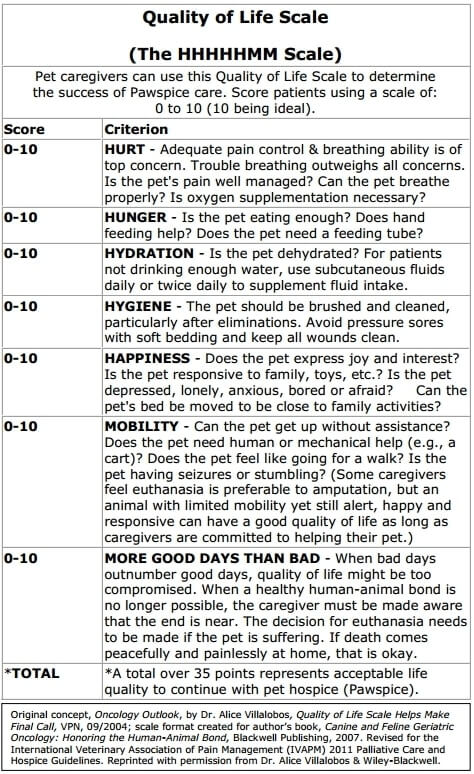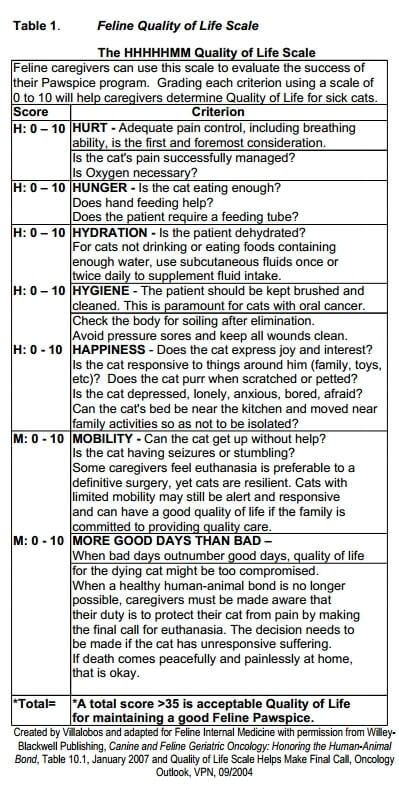
“Tuxedo Cat as The Thinker” – Original acrylic on watercolor paper by Nancy Denomme, used here with the artist’s permission
You probably don’t want to read this post. It’s not warm and fuzzy. Fair warning.
There are a few topics that routinely rattle around my brain, day in and day out, because I’m not just punching the clock here, I’m trying to change the world for the better. Euthanasia is one of those, because the topic of when to end a pet’s life, and for what reasons, speaks to the core of what veterinarians do.
We received a phone call recently, a “new client” who had inherited a cat. Realizing I could not get both sides of this story, and will only ever know the client’s viewpoint, this is what we were told:
The client had taken this cat to another local veterinary clinic because it was peeing all over her house. The other clinic failed to get blood and urine samples from the cat, because it was too aggressive to handle. That was fine with the client, though, because she didn’t have the money to pay for tests and treatments anyway. She asked the other clinic to euthanize the cat, and they refused on the grounds of a self-made policy that prohibited “convenience euthanasia”.
Where do we draw the line on “convenience”?
Some animal lovers insist you don’t truly “love” pets unless you’re willing to accept a certain level of discomfort. If you don’t like cat pee, you shouldn’t be allowed to get a cat in the first place, because some day, the cat may pee on your stuff, and if it does, you’d darn well be willing to suffer through it. If the cat is peeing because he’s developed diabetes, you darn well be willing to pay to treat him, give him shots twice a day, force syringe feed him if he stops eating, etc. etc. etc. ad nauseum.
If your dog bites your child? “You should have taken him to training and had him neutered early.”
/services/cats/blog/everything-you-never-wanted-know-about-cat-urine
If you can’t immediately afford treatment for your pets, you must be willing to rack up any available form of credit, and sell everything you own, to get your pet treated.
I mean, either you take care of them forever no matter what, or… maybe not, right. Where’s the line?
Everyone’s got their own opinion, and like most things in life, this one isn’t black and white.
Perhaps a little extreme, but you get the idea. It’s easy to say “you took on the responsibility, so you ought to see it through” when you’re judging someone else. Not so easy when the cat is peeing on YOUR kitchen counter. Or it’s YOUR kid getting bit.
Or when it’s your money on the table.
Pets are forever… aren’t they?
“Pets are forever” is all well and good, and a pious stance, but it doesn’t always work.
(This is an incredibly common, heartbreaking consequence of the overuse, and misuse, of the term “rescue”. I’m not sure it’s so wise to push pet lovers to believe that the only acceptable method of bringing a pet into your home is to remove an unwanted animal from an uncomfortable situation. Or that every. single. pet. adopted from the shelter, or “bought from a bad breeder to get it out of there”, or “rescued” off of Craigslist, qualifies as a “rescue”. But that’s a blog for another day.)
Someone else’s problem?
Given the opportunity, would you adopt this exact cat knowing it may pee all over your house, or this dog that poses an ever present injury risk?
Are you willing to foot the unwanted pet’s medical bills?
Or the medical bills of the bitten child and the associated liability claim?
Perhaps your first instinct is to say “if unwilling to rehome the cat herself, this person should at the very least take the unwanted pet to the animal shelter and let them find him a home.”
It’s easy to insist someone else should take care of problems, that we ourselves are unwilling to take on.
The cold reality is, all the animal shelters are already full. Full of healthy, young, vibrant, non-peeing cats and non-biting dogs who need a couple bucks worth of food every week, and not much more. How much of the shelter system’s resources should be put into animals who had a chance and found themselves unwanted, when there are so many euthanized every day who never even get that first chance?
An inconvenient truth
Buying a cat (or a dog) from a breeder means a cat in the shelter, who might have otherwise been adopted into your home, must be euthanized. Makes sense, right? It’s simple math. Stopping yourself from getting cat “A” allows you to get cat “B”.
Therefore, don’t shop, adopt. It’s an easy, catchy catch phrase.
If your conscience is happy with that, try this logical corollary: keeping your old, sick dog, or your unhappy, peeing cat, even if you don’t want them anymore, means a perfectly healthy and well-adjusted dog or cat at the shelter, who might otherwise have been adopted into your home, must be euthanized.
Not so easy to jump on that bandwagon, is it? But is that question really so different from “don’t shop, adopt”? Where is the line?
The logic is uncomfortably consistent. Filling your home with pet “A” instead of pet “B” means pet “B” will be euthanized. Who deserves to die more? Who ought to have the right to choose? Perhaps the person willing to give either “A” or “B” a home, but not both, should be allowed to choose which they prefer? Or should we, as society, tell them which pet they must keep, until (natural, of old age) death do they part?
Consider a (different) owner, who actually wants a cat. What if she gets one extremely grumpy or peeing cat, who cannot tolerate others and apparently is too scared to live? Should that owner keep that cat, or trade it in and open her home to five from the shelter who all get along, saving those five from euthanasia?
You may not like this question, and you may wish to push it from your mind. But please recognize that veterinarians are forced to have discussions like this with clients every day.
Does constant fear qualify as suffering?
Perhaps rather than jumping on the “pets are forever” bandwagon, or the “someone else’s problem” bandwagon, you default to asking yourself what is best for the animal. After all, shouldn’t veterinarians be advocates for the pet first?
That’s true, we should. But our conclusions as to what is best for the pet, may not necessarily match yours.
What if this unwanted cat is peeing on this woman’s stuff because he’s living in constant fear, and he misses his original mommy and daddy, and he doesn’t understand why he’s in this strange woman’s home? What if he is forever doomed to live a life of constant anxiety, every day peeing from sheer panic, his little heart racing? Anxiety is clearly far and away the most common cause of inappropriate urination, as we have discussed before. Is it better to insist this woman force the forever-scared cat to live in fear, or should she end his emotional suffering?
What if the unwanted dog is biting because he’s chronically anxious, born with a genetic predisposition to choose biting over hiding, born without the normal “bite inhibition” that we take for granted in domesticated dogs?
There is no magic pill that will take either pet’s anxiety away. No magical place where scared animals can free themselves of Earthly woes and live a life of paradise. There’s no “farm” waiting to take all the unwanted cats and dogs of the world…
If a veterinary clinic doesn’t euthanize the unwanted pet, who will?
The most uncomfortable aspect of this situation, for me at least, is knowing that if we don’t put this unwanted pet to sleep, she might either get tossed outside or taken to the shelter. I realize we have some excellent shelters in Indianapolis, and there is a fine chance he will find a lovely home, but… maybe not. If his primary problem is anxiety, is it better to send him to yet another facility, this time lined wall to wall with other pets, and no certain future of ever leaving?
Some days, advocating for our patients means helping them die young, rather than live a long and unhappy life.
How do I know when it’s time to euthanize my pet?
Euthanasia is the ultimate relief of suffering. That final sigh when an ill pet finally relaxes and lets go of all their worldly aches and pains often brings peace, both to owner and patient. It’s only after we finally let go that we are able to acknowledge how much we’ve gone through with a pet.
If your pet is experiencing a true medical issue, here are some further Quality of Life Scale guidelines that may help you decide

Click on the image to download a .pdf version

Click on the image to download a .pdf version
One final thought
I don’t have any answers to these questions, but this is the kind of thing a veterinarian is forced to think about all day, every day.
So the next time you hear a story of the pet owner who wants to euthanize an unwanted animal, I’d ask that you put yourself in their shoes before passing judgment.

R.I.P. Sophie May Magnusson, May 1999 – Feb 20, 2013. You taught me so much about how to be a doctor, and a daddy. You will be missed. ♥ 🙁
